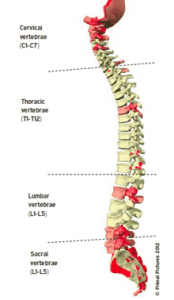Tuesday 21st January 2014
In order to perform and partake in an effective contact improvisation class Robert Turner writes ‘…if one wanted to achieve free, spontaneous movement instead of culturally imposed, habitual movement, one must develop a habit of awareness in relation to the reflexive reactions of the body, which were more basic.’ (Turner, 2010, 126) I strongly agree with Robert Turner as I constantly experience the state of staying with my habitual movement and need to move forward from this. Therefore I am going to take his theories and work with developing a state of awareness of knowing when my movement is influenced through my habitual patterns.
Today we explored further into the movement of the spine both internally and externally whilst investigating the many possibilities originating from the spine, integrating work with pelvic movement. I feel it is crucial to remember that every spine is different, which meant that when I thought I was doing something wrong or I felt that my spine was not moving like the other dancers it didn’t matter. I honed in on the fact that my spine may not be able to move in that way and focused on exploring possibilities in spite of this minor setback.
Progressing from last weeks class we paid close attention to each vertebra in the spine. ‘Visualise the spine and sense where it is and what it can do/is doing’ (Silverthorn, 2014) this allowed me to really focus on the movement of each vertebra of my spine when rolling down and up throughout the class. I suddenly felt connected to my inner movement. I developed this thought as we walked around the room initiating moved from different parts of the body, finger, elbow etc. spiralling the spine, in turn changing the direction of movement. Through laying on the floor we developed this method of spinal movement even further completing the same process as we did when walking. This allowed us to explore the potential and outcome of this technique defining the response and reaction our body gave us.
Later in the class we revisited the helix roll and crescent roll. I found that this week I was trying to direct my energy downwards into the floor, giving weight and playing with suspension, resistance and pressure. I also felt that I was paying attention to the direction in which my pelvis was going instead of trying to get the “roll” perfectly poised, I let go and gently sent direction into my pelvis. In pairs we drew attention to our pelvic movement through placing gentle pressure with our hands on our partner’s pelvis; this allowed me to explore a new initiation area for spine movement. In my opinion it is as if you are having a conversation with your body and the floor through giving weight.
Works cited:
Turner, R. (2010) Steve Paxton’s “Interior techniques” Contact improvisation and political power, 54 (3) 123-135
Kay, S. (2012) The Spine. An introduction to assessment and diagnosis, (51) 28-35
Silverthorn, T. (2014) Paxton’s material for the spine [seminar] Contact Improvisation: An Ongoing Research Lab DAN2005M, University of Lincoln, 21 January
